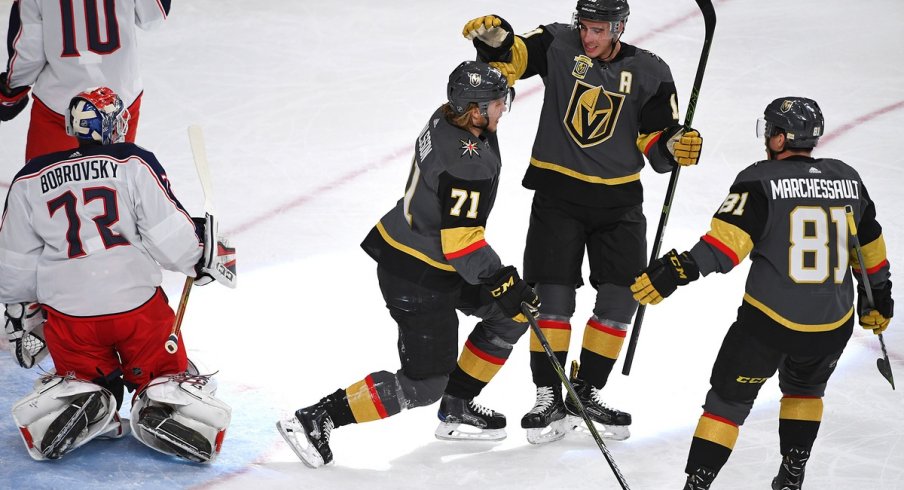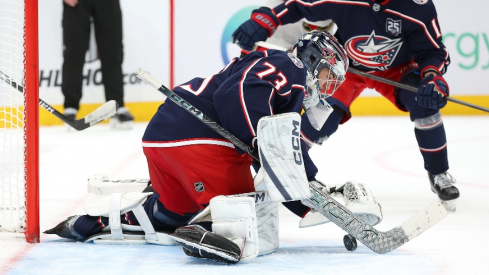The Blue Jackets' special teams play has been down significantly when compared to last season.
The Jackets finished the 2016-17 season with the 12th-ranked power play and 10th-ranked penalty kill; this season, the power play ranks dead last and the penalty kill is only slightly better, sitting in 26th. Those are both bad, but there is another special teams area where they have struggled and it’s been their play at 4-on-4.
These issues were evident in the game Tuesday night against Vegas. The Jackets allowed two 4-on-4 goals, dropping their goal differential in that situation to -4. The Jackets' goal differential on the season is -9 (excluding the goals awarded for shootout wins), per Corsica.hockey, and 44.4% of their goal differential is attributed to 4-on-4 play.
Not good.
Now, the team has only played 43:01 at 4-on-4, so we’re dealing with a small sample, but they've deserved this fate. First of all, they haven’t been able to buy a save: they have a .722 save percentage, the third-lowest in the league, ahead of only Tampa and Colorado. That should rebound as Sergei Bobrovsky, who’s been in net for the majority of those minutes, has a .916 SV% at 4-on-4 as a member of the Blue Jackets.
The problems, however, run much deeper than goaltending.
A dismal 35.71% Corsi, second-worst in the league ahead of Philadelphia (25.97%), means the Blue Jackets are spending a lot of time without the puck during 4-on-4. If these numbers were to hold over the rest of the season, it would be the worst two marks for a team since the 2012-13 lockout-shortened season.
Poor shot generation is the root of the problem: The Blue Jackets have just 20 total shot attempts in those 43 minutes – that’s one of the lowest totals in the league, and if you account for ice time discrepancies, it looks much worse. On a per-60 minute basis, the Jackets average 27.9 shot attempts, the lowest in the league. For a team that employs puck-rushing defencemen like Seth Jones and Zach Werenski, not to mention the incredibly skilled Artemi Panarin up front, it’s quite concerning they can’t create more offensive opportunities with extra space.
Expected goals (xG) accounts for a host of variables, like shot type, shot distance, whether the shot was taken on the rush, whether it was a rebound, etc. It weighs all these factors and determines how many goals a team or player should have been expected to score.
With that being said, the Jackets have scored one (1) 4-on-4 goal, and they have been expected to score 1.09. This is not a situation in which they've been unlucky.
What's so fascinating is that just a season ago, the Jackets were one of the best 4-on-4 teams in the league. They were were third last season with a 59.06% Corsi, eighth with 54.36 shot attempts per 60, and ranked second with seven goals scored and a +5 goal differential. They may have over-performed slightly as their expected goals were at 5.48, but even then, that ranked second in the league. This was a team that took over games at 4-on-4.
With such a dramatic shift from one year to the next, you have to think there were some personnel changes, be it certain players playing more or less than they did before, but that hasn’t been the case (with the obvious exception of Brandon Saad out for Panarin).
Last year, the Blue Jackets used Werenski, Jones, Jack Johnson and David Savard on defense, and up front it was Saad, Alexander Wennberg, Brandon Dubinsky and Cam Atkinson. This season it’s been the same four defensemen, but with Wennberg and Panarin and a combination of Nick Foligno, Josh Anderson and Pierre-Luc Dubois.
Dubinsky and Atkisnon have played some, but with their injuries they haven’t seen significant minutes.
It hasn’t mattered much who has been out there – it’s been a disaster. Jones and Werenski fell from a 59.38% and 59.02% Corsi, respectively, down to 45.45% and 45.83% at 4-on-4. That's a significant drop. Johnson and Savard had an even bigger fall from grace, dropping from 56.52% and 58.33% to 20% and 36%.
That’s really been the story all season. Plus, Wennberg’s numbers have been down and he’s looked lost at times without Saad. The only players to have success have been Panrin at 75% and Dubois, who is at 60%.
The team needs to get back to where they were a year ago, which was highlighted by taking advantage of the extra ice and using speed to their advantage. Getting Atkinson back should help, and he looked good in his return last night. Ideally, he can help get Wennberg back on track.
In the grand scheme of things this might not seem like a big deal, but in the Metro Division where it's so close and every point is important, every single goal matters.
Follow 1st Ohio BatteryFacebook, Twitter, Instagram and YouTube

